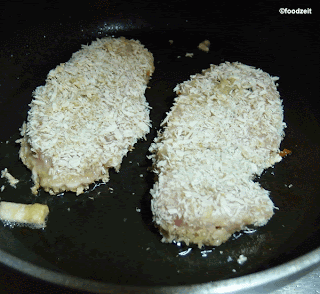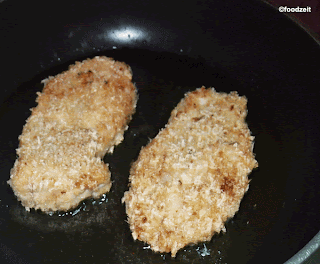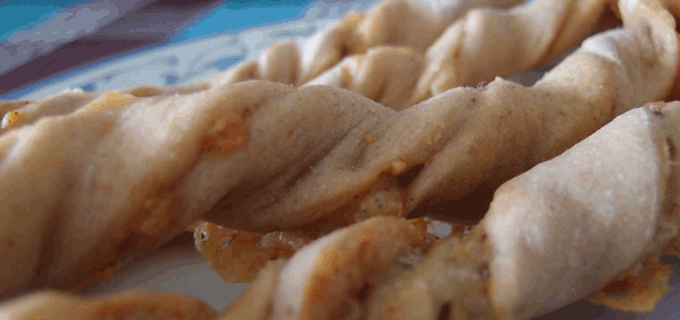 |
| Schnitzel served with some cabbage salad |
So, this one is a special edition of fast
food. A friend of mine asked me to make something that can be done in 10
minutes but that is tasty and good. So I after thinking long and carefully, I
decided to submit to this wish and make the perfect Schnitzel. The Schnitzel is
maybe the most well-known piece of food that comes from Germany. Every tourist coming to Germany will have tasted before leaving Germany: the Schnitzel. Wikipedia says the following about the Schnitzel:
"Schnitzel (German pronunciation: [ˈʃnɪtsəl]) is a breaded cutlet dish made with boneless meat thinned with a hammer (escalope-style preparation), coated in bread crumbs and fried. It is a popular food in many countries and is made from veal, chicken, beef, turkey or pork."
To this explanation I would like to add the basic information that Schnitzel derives from the German word "Schneiden" or "Geschnitten" or something similar and it means that we are talking about a piece of meat that has been cut of. Nothing more, nothing less.
Interesting is that many people that I have met acutally are convinced that the Schnitzel is a typical German food. Germans have been by-named "Schnitzel", starting from the second world war onwards until today (a good friend from the US still today likes to call me his "Schnitzel" friend).
Today I will erase this misbelief and for all those, who still believe in this false fact, please stand herewith corrected. The Schnitzel is actually not at all coming from Germany. Opinions of historians are split on the origin of the Schnitzel. Some say it come from Italy where they found the notion of the "Costoletta alla milanese", today better know as the "scaloppine milanese". Other say that it originates from Vienna, for this the world famously know "Wiener Schnitzel".
A true portion of this myth is that we Germans gladly and convenient adopted the Schnitzel and made it one of our national famous dishes. You can get the Schnitzel from north to south Germany in regular restaurants, pubs or even on the small street stalls that sell Brats and Schnitzel in a bun. Today you can also find a surplus supply of different Schnitzel recipes and ways of preparation according to the toppings and sauces that come with them, just to name a few there is the Jäger-Schnitzel, Zigeuner-Schnitzel, Paprika-Schnitzel, Käse-Schnitzel, Rahm-Schnitzel or the Cordon-Bleu. But you can also find that Schnitzel differ according to the different meat that they are made from. You can find the Schweine-Schnitzel (pork), Puten-Schnitzel (turkey hen) or the Hänchen-Schnitzel (chicken). But if you want order the original "Wiener Schnitzel" know that it is always made using veal while the "Schnitzel Wiener Art" or simply "paniertes Schweineschnitzel" is made from pork.
Anyhow, enough of the dry theory, you can find many more hungry fun facts about the Schnitzel on Google. Let's get started trying to make the prefect Schnitzel, shall we? I actually tried quite a few recipes, but they are more or less the same and the most important things in making a perfect Schnitzel are two steps, the coating and the frying. The idea about the Schnitzel is to enclose the piece of meat with a protective coating so that as little meat juices evaporate as possible. This way you will get a perfect Schnitzel with a crispy coating and a soft and juicy heart of meat.
"Schnitzel (German pronunciation: [ˈʃnɪtsəl]) is a breaded cutlet dish made with boneless meat thinned with a hammer (escalope-style preparation), coated in bread crumbs and fried. It is a popular food in many countries and is made from veal, chicken, beef, turkey or pork."
To this explanation I would like to add the basic information that Schnitzel derives from the German word "Schneiden" or "Geschnitten" or something similar and it means that we are talking about a piece of meat that has been cut of. Nothing more, nothing less.
Interesting is that many people that I have met acutally are convinced that the Schnitzel is a typical German food. Germans have been by-named "Schnitzel", starting from the second world war onwards until today (a good friend from the US still today likes to call me his "Schnitzel" friend).
Today I will erase this misbelief and for all those, who still believe in this false fact, please stand herewith corrected. The Schnitzel is actually not at all coming from Germany. Opinions of historians are split on the origin of the Schnitzel. Some say it come from Italy where they found the notion of the "Costoletta alla milanese", today better know as the "scaloppine milanese". Other say that it originates from Vienna, for this the world famously know "Wiener Schnitzel".
A true portion of this myth is that we Germans gladly and convenient adopted the Schnitzel and made it one of our national famous dishes. You can get the Schnitzel from north to south Germany in regular restaurants, pubs or even on the small street stalls that sell Brats and Schnitzel in a bun. Today you can also find a surplus supply of different Schnitzel recipes and ways of preparation according to the toppings and sauces that come with them, just to name a few there is the Jäger-Schnitzel, Zigeuner-Schnitzel, Paprika-Schnitzel, Käse-Schnitzel, Rahm-Schnitzel or the Cordon-Bleu. But you can also find that Schnitzel differ according to the different meat that they are made from. You can find the Schweine-Schnitzel (pork), Puten-Schnitzel (turkey hen) or the Hänchen-Schnitzel (chicken). But if you want order the original "Wiener Schnitzel" know that it is always made using veal while the "Schnitzel Wiener Art" or simply "paniertes Schweineschnitzel" is made from pork.
Anyhow, enough of the dry theory, you can find many more hungry fun facts about the Schnitzel on Google. Let's get started trying to make the prefect Schnitzel, shall we? I actually tried quite a few recipes, but they are more or less the same and the most important things in making a perfect Schnitzel are two steps, the coating and the frying. The idea about the Schnitzel is to enclose the piece of meat with a protective coating so that as little meat juices evaporate as possible. This way you will get a perfect Schnitzel with a crispy coating and a soft and juicy heart of meat.
In order to reach this, the first thing we
have to pay attention to is the coating of the meat. I follow the idea that
mixing the flour, eggs and spices of the coating upfront and not keep them
separated and dip the meat in one coating after another, loosing half of the
previous coating. By mixing those things together so that the coating is thick
and like a thick sauce béchamel, we achieve a consistent and thick enough mixture
that will stick well and that will protect the meat. I also do not use a meat
hammer to thin the meat out. I think it is not worth it because the meat will
return to its old form more or less, once frying it.
So I simply skip this step. So, here is a bit an unusual but tasty Schnitzel recipe for you.
So I simply skip this step. So, here is a bit an unusual but tasty Schnitzel recipe for you.
Ingredients:
- 2 pieces of nice and lean pork meat
- Salt and pepper to taste
- 3 EL flour
- 2 eggs
- 1 table spoon of Dijon Mustard
- Bread crumbs
 |
| Ingredients |
Mix the spices, flour and eggs together
and make sure the consistency is as above described, if it's too runny, add
some flour or add some more egg if it's too dry. Put the mix in a flat plate so
you can immerse the pieces of meat in it, then put the bread crumbs in another flat
plate. Now take the pieces of meat and put them in the mixture and coat them
well from both sides. Then immerse them in the bread crumbs, the coating should
be sticky enough to also make the breadcrumbs glue will to the mix. Now we got
the protective coating around the meat, it’s time for the frying.
I actually like to fry the Schnitzel
different than other pieces of meat starting with a medium heat and later on
finish the frying on a higher temperature. So first, add some butter to a
frying pan and put it on medium heat. Wait till the butter is melted and hot
enough. Then immerse the Schnitzel in the hot butter and start off to fry the
Schnitzel. When the coating just reaches a solid state, turn the Schnitzel
around and fry from the other side until the coating is solid there as well.
 |
| Frying the Schnitzel on low flame to solidify the coating |
Then
turn it around again and continue the frying until the coating starts to gets
slightly brown, and then it’s time to turn around again and turn the heat down
on 1/3.
 |
| Schnitzel is lightly brown already and browning from the other side |
Like this I have enough time to prepare the other things for dinner
while the Schnitzel browns slightly from the other side. When I am ready I will
crank up the heat for a last turn. This time I am frying the coating from both
sides until it is nice and crispy, turn it around and finish the other side
off. Then take it out, plate it up immediately.
 |
| Finished Schnitzel nice and brown with a crispy coating and a juicy piece of meat inside |
Schnitzel normally is perfect
with a slice of lemon and some French fries, but it's equally good with some Swabian potatosalad or some Bavarian cabbage salad. Here you go, this one is for you Dude, enjoy your less than 10
minutes Schnitzel and let me know how it tasted.











This looks so good and easy!!! Thumbs up!!!
ReplyDeletethanks a lot :). Try it out and let me know how it was. I think it's quick and easy and really tasty, the crispiness and the juicy meat inside...
ReplyDeleteIt looks good, it tastes good and is easy to make! Nice one dude.. First schnitzeling test got a bit carbonized, the 2nd one was perfect. Mission accomplished; within 10 min nice & decent food on the table!
ReplyDeleteHaha, Dude, the carbonized version. Of course I know exactly how that looks like. For this reason I like the way of making Schnitzel as you do everything on low heat first, no risk of canonization. Good to hear you like this one. Think I must cook a few more 10 minute dishes in the future :)
ReplyDeleteLooks yum yum and i wonder the cabbage salad , is it like the one we have tasted before in Mama German?
ReplyDeleteYes dear Sis, it is that one. Here is the recipe for that very cabbage salad if you want to make it at home, it's easy. Find the recipe over here:
ReplyDeletehttp://foodzeit.blogspot.de/2012/11/bavarian-cabbage-salad.html
Hi bro, thanks. I actually searched the cabbage recipe last time. However i still dont have time to make it. I will try one day hehehe.
ReplyDeleteWhy search? It's right here: foodzeit.blogspot.com/2012/11/bavarian-cabbage-salad.html you can do it at home hehe, very easy and very delicious :)
ReplyDeleteOh yes, i saw your link already. Btw, is there any difference with the sour cabbage salad? Is it called sauerkraut?
ReplyDeleteHm, I see why you ask that, it's because you are a Kimchi maker and fan. Yeah, Sauerkraut is like the German Kimchi, but then it's also not, it’s more like an ingredient. Sauerkraut was a way of preserving the cabbage for the very, very cold German winters in which there was no fresh food to eat, but it’s more like an ingredient and it’s not so much of a salad, I never ate it cold or raw before, we usually eat it warm with potatoes, as Sauerkraut soup. But then I also saw some recipes of people that eat it cold, still, I would not as it’s just not traditional style. Next time I put my fav Sauerkraut soup recipe here for you. I also enjoyed Kimchi soup a lot when I was in Korea…
ReplyDeleteOk sure. Now make me want to eat kimchi soup
ReplyDeleteHaha you should, by all means. One of these days you have to write a guest blog: how to make kimchi...
ReplyDelete